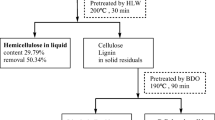Abstract
The characteristics of mould resistance of bamboo after hydrothermally treated at 140 °C with water only, NaOH, NaAc aqueous solution, then heat treated at relatively mild conditions (180 °C) were determined. Strong degradation of hemicelluloses, modification of lignin and creation of phenolic compounds in the bamboo by the heat treatment could inhibit the mould growth to some extent.
Similar content being viewed by others
References
Boonstra MJ, Tjeerdsma B (2006) Chemical analysis of heat treated softwoods. Holz Roh Werkst 64:204–211
Hillis WE (1984) High temperature and chemical effects on wood stability. Wood Sci Technol 18:281–293
Humar M, Petric M, Pohleven F (2001) Changes of the PH value of impregnated wood during exposure to wood-rotting fungi. Holz Roh Werkst 59:288–293
Ishikura Y (2011) Changes of wood properties treated with aqueous amine solution, bending tests and X-ray analysis of wood after amine treatment. J Mater Sci 46:3785–3791
Ran LX, Wu GJ, Lin XJ (1997) Physiological characteristics of moulds infecting bamboo wood and mould Control. J Cent South For Univ 17:14–19
Rowell R, Ibach R, McSweeny J, Nilsson T (2009) Understanding decay resistance, dimensional stability and strength changes in heat treated and acetylated wood. In: 4th European conference on wood modification, vol 4. Stockholm, Sweden. pp. 489–503
Sibel Y, Engin DG, Umit CY (2006) Mechanical and chemical behavior of spruce wood modified by heat. Build Environ 41:1762–1766
Sun FL, Mao SF, Wen GF (2006) Anti-mold effects of bamboo timber treated with different solutions. J Zhejiang For Coll 23:135–139
Acknowledgments
The authors are grateful for financial support of the Priority Academic Program Development of Jiangsu Higher Education Institutions (PAPD) and the Key Project of the National Twelfth-Five Year Research Program of China (2012BAD30B01).
Author information
Authors and Affiliations
Corresponding author
Rights and permissions
About this article
Cite this article
Cheng, D., Jiang, S. & Zhang, Q. Mould resistance of Moso bamboo treated by two step heat treatment with different aqueous solutions. Eur. J. Wood Prod. 71, 143–145 (2013). https://doi.org/10.1007/s00107-012-0654-3
Received:
Published:
Issue Date:
DOI: https://doi.org/10.1007/s00107-012-0654-3




